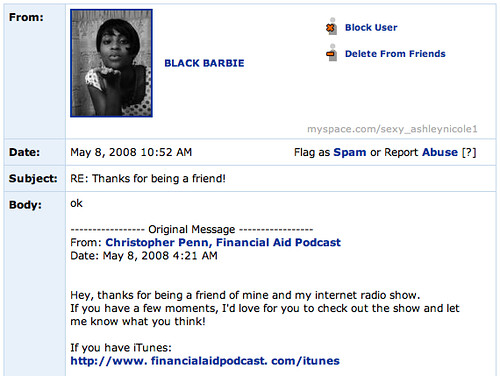Check out the best marketing podcast ever made in a doughnut shop, Marketing Over Coffee. Today’s a double shot as we try out the Flip Cam.
Author: Christopher S Penn
-
Review: Flip Ultra 2GB
 I bought a Flip Ultra today. Lots of positives and negatives about this little camera, and limitations that need to be understood to get the best performance out of it.
I bought a Flip Ultra today. Lots of positives and negatives about this little camera, and limitations that need to be understood to get the best performance out of it.Positives
- AA batteries
- 2 GB internal memory for 60 minutes of record time
- Firmware updates
- Light
- Portable
- Stupid simple
Negatives
- Not going to sub for a high quality camcorder any time soon
- Very susceptible to shake without tripod
- No options for expandability
- Fixed-length lens (yes, there’s a digital zoom, which is a joke)
Now, I own a lot of gear. When I need to upgrade to quality video, I break out my MiniDV camera because nothing Flash-based captures video with the same quality as tape that I’ve found yet.
When I want a balance of portability and optics, I’ll use my Sanyo Xacti.
When I want to record a lot of video at conferences, this is the camera I’m going to use.
There is one and only one reason I bought a Flip Ultra:
The Flip Ultra uses AA batteries.
When I’m at conferences, rarely do sessions last more than 60 minutes, so the Flip’s built in memory limitation isn’t a big deal.
What is a big deal is that this little camera takes AA batteries. Rare is it when I don’t have a pile of 12 or so with me at any given time. Between sessions, I can dump the memory to my MacBook Pro and swap out batteries.
If I use the MiniDV camera, I have to change tapes and use the AC adapter, which is a huge stumbling hazard for everyone around me.
If I use the Xacti, I have to carry the AC charger with me and recharge the battery (and its two spares) throughout the day, which is a pain in the butt.
If I use the Flip, I just swap out AAs and recharge everything in the hotel room overnight.
The Flip is a single-use camera for me – I bought it specifically for use at conferences. I’m not going to film the next major motion picture with it, and I wholly acknowledge that it isn’t intended for that use at all. It will allow me, however, to capture lots of “good enough” video at conferences I go to, with a minimum of hassle when it comes to power and memory.
-
Food for thought on Memorial Day
Every gun that is made, every warship launched, every rocket fired signifies, in the final sense, a theft from those who hunger and are not fed, those who are cold and are not clothed.
This world in arms is not spending money alone.
It is spending the sweat of its laborers, the genius of its scientists, the hopes of its children.
– President Dwight D. Eisenhower, 1956
Food for thought: the United States military budget is $713 billion dollars. (Slate) For every American man, woman, and child, that’s $2,376 paid out every year.
Whatever your politics, understand that this reflects our national priorities, where we put our tax dollars to work, governed by who we vote for.
Food for thought: two months’ worth of the military budget would wipe out the student loan debt of every current student in America and then some.
Four months’ worth would send every student academically eligible to attend college to school for free.
Three months’ worth would pay for the entire reconstruction of the Gulf Coast, erasing Katrina’s damage.
As we remember those who have given their lives for the country, please consider carefully who you vote for this fall, and urge every American you know to get educated about the candidates and participate by voting and staying involved in the political process after the election. Hold your elected representatives accountable by staying in communication with them, sending them email, faxes, YouTube videos, whatever it takes to ensure your voice continues to be heard about the priorities that are important to you.
“Pray for the dead. Fight like hell for the living.” – Mary “Mother” Jones
-
Staycationing
Just added a new article to the Financial Aid Podcast blog – how to staycation properly. In a time of record gas prices, record food prices, record airline prices, record everything, this article will hopefully inspire you to try something different and lighten both your spirits and the load on your wallet.
-
Hope, advisement, and Melissa Rakes
One of the highlights of this past EASFAA conference was not at the conference at all, but in the bar after the Monday sessions. I had the good fortune to sit down with Melissa Rakes, an Ed.D. student looking at how advisement works, and we got to talking about one of my favorite things – marketing, of course. We chatted about her doctoral thesis and a few different ideas and systems that could be applied to academic advisement, which was a lot of fun.
I kept asking nearly absurd questions about porting existing business, sales, marketing, and motivational systems to education, because it seems to me that if Amway Motivational Organizations can generate books, tapes, CDs, etc. to keep their members moving ahead in an organization that statistically holds little hope for them at all, it should be a cakewalk for academic advisors to use the same tools and technologies to motivate their students in an educational system that DOES generate good results.
One of the highlights of the conversation was on the topic of branding. I was mentioning Ze Frank’s fantastic explanation of branding as emotional aftertaste, and asked Melissa what she thought higher education’s brand was and is. We concluded that it’s hope. Not anything necessarily specific – lots of people go to college for lots of reasons, but hope seems to be a common thread. Hope for a great job, for freedom and independent, for a better future than past, hope as an emotion.
I thought of the students who are first in their families to go to college, and the hope, excitement, and trepidation that they must feel in their first days in school – and how processes such as financial aid, enrollment, and other parts of academia’s paperwork bureaucracy do their very best to squash that hope under a mountain of paper.
If advisors in higher education could communicate, reinforce, and energize hope consistently with the same aggressive methods of motivation that business uses, I’d bet that retention and dropout rates would plummet. Melissa’s got a few great projects underway, and I wish her outrageous success in all of them. I suspect she’s going to be one of higher education’s rock stars of the future.
-
Pimping the Financial Aid Podcast
I’m happy to say that the Financial Aid Podcast just hit episode 800. Check out the episode – it’s 5 success stories powered by new media, ways in which new media has made a real difference.
-
Ask, ask, ask
I’ve been looking again at MySpace, as a recent blog post detailed. One of the things I’ve been looking at is the depth of engagement. Is a friend relationship enough to market on? What is the value of a MySpace friendship?
Over the last five days, I’ve been sending out 200 messages a day or so to my MySpace friends, advertising the Financial Aid Podcast. It’s themed pretty basically:
- Thanks for being a friend of mine and of my show.
- Here’s three links to iTunes, Google Reader, and the site.
- Please subscribe.
I started with a Feedburner number of about 1,000. The show had been static around that number for a while, a couple of months at least. Today? Hit a new record – the last four out of five days.
Ask. Ask those in your network to get connected, ask them to take action, ask them to be more involved in your community efforts. If you don’t ask, you definitely won’t receive.
-
The Power of Extreme Fatigue
 Last night the main sewer line at the house backed up around 10:30 PM, which necessitated a call to Roto Rooter. 4 1/2 hours and $354.73 later, the sewer line was clear (plumber: “Don’t use Charmin. It clogs up everything. I know people like soft toilet paper for their ass, but that’s an expensive habit.”) and the clock struck three – which meant that it was literally 124 minutes before the alarm was scheduled to go off.
Last night the main sewer line at the house backed up around 10:30 PM, which necessitated a call to Roto Rooter. 4 1/2 hours and $354.73 later, the sewer line was clear (plumber: “Don’t use Charmin. It clogs up everything. I know people like soft toilet paper for their ass, but that’s an expensive habit.”) and the clock struck three – which meant that it was literally 124 minutes before the alarm was scheduled to go off.So this morning I sit very carefully at my desk, ensuring that I don’t work on any systems vital to the company, because two hours of sleep makes you exceptionally prone to critical mistakes – you know, the “hey, did I just format the hard drive of our web server?” kind. Making sure that on my docket for the day is nothing mission critical.
However, extreme fatigue does have its merits. I tend to think a lot more creatively and non-linearly when I’m over-tired, because my brain just operates differently in a low-sleep state. Sometimes really neat ideas that I’d never create fully rested come out, and I jot those down. When I’m rested, they can be refined and tuned up, but the raw materials are still good.
That’s the other important thing – overly fatigued essentially brings with it a variant of attention deficit and short term memory loss, so if you have good ideas, it’s super important to be near an input device – phone, keyboard, notepad, etc. – because those ideas will vanish FAST.
Some thoughts on a Wednesday morning.
-
If you're new here…
… be sure to check out the Quotes page. It’s a slowly growing compilation of things I learn, hear, read, etc. that resonate, little pieces of profound knowledge that help me.
Profound knowledge, as defined by Anthony Robbins, is knowledge that is quickly and easily transmitted, but life-altering. Once you get it, you can never go back to being the person you used to be. One of my favorite examples of profound knowledge is the rule of thirds in photography.
Look at your viewfinder on your digital camera. Imagine a tic-tac-toe grid on it. Line up your pictures to put the subjects at the intersections of the lines.
Instantly, your photography changes – once you understand the concept, you can’t ever go back to the person you were just moments ago. That’s profound knowledge.
The quotes page is a place where I store the pieces as I find them.

